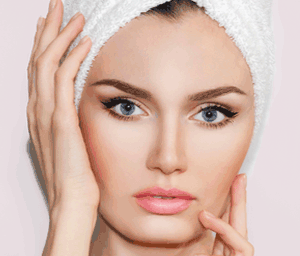The Cosmetic Benefits of Hormone Replacement Therapy
In addition to living longer and with more vitality, one of the benefits of taking care of one’s health is maintaining a more youthful and attractive physical appearance. As a person journeys through life, being confident in the way one looks continues to hold significant emotional and psychological benefits, particularly as we age.
‘Looking good’ not only boosts a person’s self-esteem and confidence but also enhances their overall quality of life. Studies have shown that the emotional and psychological benefits of looking good as one gets older extend far beyond mere aesthetics. A positive body image actually improves social interactions and gives people a greater sense of vitality and happiness.
In recent years, an increasing body of research has shed light on the remarkable cosmetic and aesthetic benefits of hormone replacement therapy (HRT). While HRT is most commonly associated with its role in alleviating symptoms of menopause, emerging evidence suggests that it also possesses the power to enhance the appearance of hair, skin, and body composition.
In this article, the hormone replacement therapy experts at SottoPelle® delve into the science behind the appearance rejuvenating effects of HRT and explore how it can help you maintain a more youthful and vibrant appearance.
Hormone Replacement Therapy for Hair Restoration
One of the most frustrating visible signs of aging is the gradual thinning and loss of hair. However, hormone replacement therapy has shown promising results in promoting hair growth and reversing the effects of age-related hair loss.
This can be attributed to the role of hormones, such as estrogen and testosterone, in stimulating hair follicles and promoting hair growth. Estrogen, in particular, helps extend the growth phase of hair, leading to thicker, healthier strands. Similarly, testosterone aids in preventing hair loss and promoting hair regeneration in both men and women.
In a study entitled Hair loss in women: medical and cosmetic approaches to increase scalp hair fullness, the researchers highlighted the significance of hormones, such as estrogen and testosterone, in stimulating hair follicles and regulating hair growth. The study concluded that hormonal imbalances, including those occurring during menopause, can contribute to hair thinning and loss and laid the groundwork for understanding the connection between hormones and hair health. [1]
By restoring hormonal balance through HRT, many individuals can experience improved hair quality, density, and overall appearance.
Hormone Replacement Therapy for Skin Rejuvenation
Hormones also play a crucial role in maintaining the health and vitality of the skin. Estrogen, for instance, contributes to the production of collagen, a protein that provides structural support and elasticity to the skin. With age, the decline in estrogen levels leads to a reduction in collagen synthesis, resulting in sagging skin, wrinkles, and loss of elasticity. By replenishing estrogen levels through HRT, individuals can stimulate collagen production, leading to firmer, more supple skin with reduced wrinkles and fine lines.
Hormones also influence the hydration and oil production of the skin. Estrogen helps maintain optimal moisture levels, preventing dryness and enhancing the skin’s natural radiance. Testosterone, on the other hand, regulates sebum production, preventing excessive oiliness and reducing the likelihood of acne breakouts.
In a 2017 clinical study, researchers investigated the impact of hormone therapy on skin aging in postmenopausal women. The researchers analyzed the effects of estrogen and progesterone therapy on various skin parameters, including elasticity, hydration, and wrinkle formation. The results demonstrated that hormone therapy significantly improved skin elasticity and hydration, while reducing the severity of wrinkles. The study concluded that hormone therapy could have positive effects on skin aging in postmenopausal women. [2]
Another study conducted in 2019 examined the influence of hormone replacement therapy on skin texture and appearance in postmenopausal women. The researchers evaluated skin elasticity, firmness, hydration, and pigmentation in women undergoing hormone therapy. The findings indicated that hormone replacement therapy resulted in improved skin elasticity and firmness, increased skin hydration, and a reduction in pigmentation irregularities. The study concluded that hormone therapy positively affected several skin parameters, suggesting its potential for skin rejuvenation. [3]
By restoring hormonal balance, hormone replacement therapy can contribute to a more youthful, hydrated complexion, and improved skin texture.
Hormone Replacement Therapy for Fat Loss
Hormone imbalance can also significantly impact body composition, leading to increased fat accumulation and loss of muscle mass. Hormone replacement therapy can help address these concerns and promote a leaner, more toned, and aesthetically pleasing physique.
In many patients, HRT can help to promote fat loss. This is because hormones, such as estrogen, play a role in fat metabolism. Estrogen helps to break down fat and promote fat loss. Estrogen, also helps regulate fat distribution, favoring a more feminine pattern by depositing fat in the breasts, hips, and buttocks, while minimizing abdominal fat.
This is why menopausal women often start accumulating fat “in all the wrong places” – especially the belly. As estrogen levels decline, fat can accumulate.
In a 2019 research study, a total of 120 menopausal women were randomly assigned to receive either HRT or placebo for 12 months. After 12 months, the HRT group had a significant decrease in total abdominal fat (P = 0.003), visceral fat (P = 0.001), and subcutaneous fat (P = 0.002) compared with the placebo group. [4]
Hormone replacement therapy can help to replace depleted estrogen levels in women and promote fat loss.
Hormone Replacement Therapy for Building Muscle
Testosterone, on the other hand, aids in preserving lean muscle mass and promoting fat metabolism. By balancing hormone levels through hormone replacement therapy, both men and women can achieve a healthier and more attractive body composition, with reduced body fat and increased muscle definition.
Moreover, HRT can contribute to improved bone density, mitigating the age-related decline commonly associated with osteoporosis. Stronger bones provide a more supportive framework for the body, enhancing posture and overall appearance.
SottoPelle® Method Hormone Replacement Therapy
The health benefits of hormone replacement therapy have long been understood. Now, as added benefit HRT has been clinically proven to cosmetically improve hair, skin, and body composition.
Through the restoration of hormonal balance, HRT can rejuvenate hair, revitalize the skin, eliminate or redistribute fat, and help build muscle in many individuals – for a more youthful and vibrant appearance.
If your skin, hair and body are starting to show frustrating signs of aging, ask your doctor about about the anti-aging benefits of SottoPelle Method hormone replacement therapy. Or find a certified SottoPelle® Method BHRT provider in your area HERE.
A certified SottoPelle® Method provider can conduct blood testing to assess your hormone levels – and develop a hormone replacement therapy plan to help you feel and look younger so you can live life with health, vitality and confidence now and for years to come.
IMPORTANT DISCLAIMER: This article is provided as general information only and is not intended to be used as medical advice. While the benefits of hormone replacement are well documented through clinical research, we are not representing that hormone therapy is a “cure” for any disease. Only your treating physician can determine if hormone replacement may be a beneficial part of your healthcare regimen, based on your age, overall health, risk factors, and lifestyle.
Citations:
- Rieder EA, et al. (2016). Hair loss in women: medical and cosmetic approaches to increase scalp hair fullness. https://www.ncbi.nlm.nih.gov/pmc/articles/PMC5328147/
- Thornton MJ, et al. (2017). Hormones and the hair follicle: a guide for clinicians. https://www.ncbi.nlm.nih.gov/pmc/articles/PMC6273829/
- Carrasco DJ, et al. (2019). Effects of hormonal replacement therapy on the skin of postmenopausal women: a prospective, randomized, controlled study. https://www.ncbi.nlm.nih.gov/pmc/articles/PMC6547756/
- Zhang Y, Zhang H, Zhang L, et al. (2019) Effects of hormone replacement therapy on abdominal fat distribution in menopausal women: a randomized controlled trial. Menopause. 2019;26(1):109-116. https://academic.oup.com/menopause/article/26/1/109/5254864


